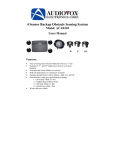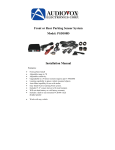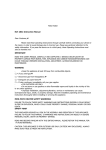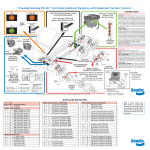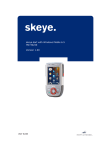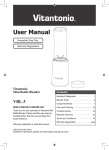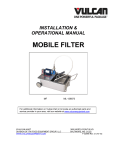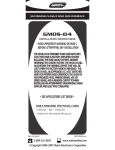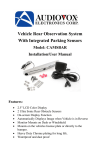Download Audiovox ACAB104 Installation Manual
Transcript
4 Sensor Backup Obstacle Sensing System Model: ACAB104 Installation Manual 0° Features: • • • • • • • Four reversing sensors detect obstacles between 1- 7 feet Includes 0°, 5°, and 10° angle sensor sleeves to fit most bumpers Activates only when vehicle is in reverse Will not drain battery or void factory warranty Includes speaker/buzzer with 3 settings - high, low, and off Four detection zones give the following warnings: 1 = slow beep within 5-7 feet 2 = medium beep within 3-5 feet 3 = fast beep within 1-3 feet 4 = steady tone within 1 foot Works with any vehicle 5° 10° TABLE OF CONTENTS Warnings....................................................................................2 Product Description ...................................................................3 Packing List ...............................................................................3 Installation Instructions .............................................................4 Mounting the Sensors .......................................................4 Installing the Power Harness ...........................................8 Mounting the Speaker.......................................................9 Mounting the Control Module ........................................10 Specifications...........................................................................11 Maintenance .............................................................................11 Toubleshooting.........................................................................11 1 Warnings This product is intended to assist in safe driving by signaling the driver of obstacles behind the vehicle while the vehicle is in reverse. You, as the driver, are solely responsible for the safe operation of your vehicle and the safety of your passengers according to your local traffic regulations. Do not use any features of this system to the extent it distracts you from safe driving. Your first priority while driving should always be the safe operation of your vehicle. Audiovox Electronics Corporation cannot accept any responsibility whatsoever for accidents resulting from failure to observe these precautions or safety instructions. 1. This product utilizes high voltage. Any unauthorized modifications or damage to the product may result in electrical shock. Handle all components with care. Inspect regularly for damage to components and cabling. 2. You are responsible for ensuring that the installation of this product does not void or affect the vehicle manufacturer’s warranty. Audiovox Electronics Corporation or its subsidiaries are not liable in full or in part for improper installation resulting in loss or damage to your property, or for voiding all or part of the vehicle manufacturer’s warranty. 3. Do not apply excessive force to any of the components contained within this kit. Excessive force used before, during or after installation that results in a damaged or non-functional part will void all warranties. 4. Please follow the procedures in this installation manual. Improper installation or modification of this product will void all warranties. 2 Product Description This 4 Sensor Backup Obstacle Scanning System is designed to assist the driver by providing an alert when an object is behind the vehicle whenever the vehicle is shifted into reverse. Never rely solely on this product to ensure the area is clear of children and/or obstructions. This product is not intended to replace existing safety procedures, but rather to add an additional safety tool for your vehicle. Packing List The model ACAB104 Backup Obstacle Scanning System consists of the following items: 1. 2. 3. 4. 5. 6. 7. Control box with Velcro pad Sensors, 4 each, with 6m length of cable Power cable, 4m length of cable Speaker with 3m length of cable 4 each of the following sensor sleeves: a. 0 degree b. 5 degree c. 10 degree Hardware bag includes: a. 2 tap connectors Installation manual 3 Installation Instructions Before installing this product, take time to familiarize yourself with the items in the box and use the packing list to verify all parts are present. Mounting the Sensors 6-12" 6-12" Equal Spacing of Sensors 19.5-27.5" Figure 1 Marking and Drilling Holes 1. Mark the locations of the sensors on the rear bumper using a grease pencil. a. Identify the sensors height on the bumper and mark. The sensor height should be between 19.5” and 27.5” from the ground. b. Mark the location of the left sensor by measuring between 6” to 12”from the left edge of the bumper toward the center. Repeat from the right edge of the bumper. c. Determine the center of your bumper and mark. Measuring 12” to 18” from the center mark, determine the location of the center two sensors and mark, keeping the four sensors equally spaced (see Figure 1). d. Inspect behind the bumper where the sensors are to be located to check for possible obstructions, including metal braces, electrical wires, and clearance. The sensors need 1” of clearance behind the bumper to be fully inserted and mounted securely. Do not mount sensors directly above exhaust pipes. Relocate the sensors if any obstruction exists. 4 2. Choose one of the following mounting methods for your vehicle a. Use the sensor sleeves provided to compensate for contours in the vehicles bumper. b. If the surface is 90- 95 degrees perpendicular to the ground, install the sensors directly in the bumper (see Figure3). 3. Before drilling the holes, use a center punch to make a dimple on the bumper to prevent the drill from slipping from the intended mark. 4. Drill the sensor holes. o When using the sensor sleeves, use a 28mm hole saw (part# AS28MMHS). Drill at a perpendicular angle to the bumper (see Figure 2). o When installing the sensors directly in the bumper, use a 22mm hole saw and drill at a perpendicular angle to the bumper (see Figure 2). o When drilling a metal bumper, remove the sharp edges using a round metal file. Be careful not to enlarge hole when filing. Figure 2 5 Choosing the Correct Sensor Sleeve A rro wh ea d u pwa rd 90 -9 5 Figure 3 The position of the sensors must be between 90°-95° perpendicular to the ground (Figure 3). Due to different contours in vehicle bumpers 3 different sensor sleeve angles (0°, 5°, & 10°) have been included with this system to aid in the proper installation of the sensors at the proper angle to the road. If the sensor angle is less than 90° the sensors may detect the road as an object and emit a constant beeping tone, however if the sensor angle is greater than 95° objects may not be detected and no beeping signal will be emitted. 6 Installing the Sensor Sleeve and Sensors NOTE: When installing the sensors into the sensor sleeves, push on the outer ring of the sensor only. Never push on the center of the sensor.. 1. Press the pre-selected sleeve into a 28mm hole in the bumper, making sure the thinner edge of the sensor sleeve is at the top of the hole. 2. Run the sensor wires through the sensor sleeves in the bumper. 3. Press on the outer ring of the sensor and push until the sensor is flush with the sensor sleeve. The sensor should fit snugly into the bumper and lock into place. 4. Determine where the sensor wires will enter into the trunk area or passenger compartment. Many vehicles have a factory grommet to allow routing of wires from the outside to the inside of the vehicle. If needed, drill a hole to route the wires into the vehicle, taking care when drilling metal. Smooth edges with a round metal file and use a rubber grommet to protect the wires. 5. Feed the sensor wires through the factory grommet or other opening into the vehicle for connection to the control module (e.g., into the cab of most trucks or the trunk of passenger cars). NOTE: Once the wires are passed through, make sure there is enough wire to route to the control module. Check that the sensor wires will not be pinched by moving parts or panels. 6. Cable tie the sensor wires and the power harness wires behind the bumper, keeping them away from the exhaust system or moving suspension parts (install power harness before using cable ties). Do not pull on the sensor wires near the sensor shaft exit point, as this may damage the inner connections. 7 Installing the Power Harness Tap/Run Connection 1. 2. Wire the Power Harness to the vehicle’s reverse lamp. a) Locate the reverse lamp in the tail light assembly. Using the tap connector supplied, perform the following steps: i. Place the un-stripped positive lead wire on the run channel. ii. Insert the un-stripped red power wire completely. iii. Fold the tap connector back over the wires and make the connection by crimping the u-contact down flush with the plastic insulator. iv. Close the top hinged cover until latched. b) Attach the black wire to the ground. i. Place the un-stripped ground lead wire on the run channel. ii. Insert the un-stripped black ground wire completely. iii. Fold the tap connector back over the wires and make the connection by crimping the u-contact down flush with the plastic insulator. iv. Close the top hinged cover until latched. Route the power harness wires with the sensor wires to the control box. 8 Mounting the Speaker The speaker has three volume settings: Off, Hi, and Low. Since the speaker can be adjusted as needed, you should mount the speaker in an accessible location in the interior. 1. Route the wires for the speaker to the area where you will install the control module. Make sure they will not be pinched by the panel or moving parts. 2. Clean the mounting location to ensure good adhesion. When the location is dry, peel the backing strip off the double sided tape on the back of the speaker and press on the cleaned surface. Use the optional mounting screws (provided), if necessary. 9 Mounting the Control Module Determine a dry place inside the vehicle (out of the way) to mount the control module (e.g., behind an inner body panel), making sure that all wiring will reach the intended location. 1. Plug the sensor wires, speaker and power harness into the control module before mounting. The sensor must be plugged into the corresponding socket (see Figure 4). The control module is pre-fitted with Velcro for mounting. 2. The Sensitivity Adjustment (E) setting controls the sensitivity of the sensors. The unit is shipped in the high setting. To lower the sensitivity, pull the jumper off the middle/right post and place it over the left/middle post. 3. Clean the pre-selected mounting area to ensure good adhesion. 4. When the surface is dry, peel the backing off the Velcro pad and attach the control module. Sensitivity Adjustment(E) Low High Figure 4 10 Speaker cable Sensor Power cable A B CD Specifications Power Supply Current Draw Detecting Distance Sensor Cable Length Control Box Size Operating Temperature Range DC12V <180mA 1 to 7 ft 23 ft 4.125”x 3”x .830” -40°F~ 176°F Maintenance Though your backup system requires minimum care, you should maintain its condition and performance using the following the guidelines: • Keep the control box away from moisture, extreme heat or cold. • Keep the sensors free from snow, ice, and debris. Troubleshooting Problem System does not beep when reverse gear is engaged and object is in range System beeping without obstacle behind vehicle Low sensitivity Re-start often No obstacles present and system is beeping Solution 1. Check if ignition/reverse light on 2. Check power cable connection 3. Check switch on speaker 1. Remove anything mounted on the vehicle higher than the sensor 2. Verify sensor is installed at the correct height 3. Verify sensor is in the correct position 4. Check all connections 5. Reduce sensitivity 1. Clean sensors 2. Check all connections 3. Check if voltage is normal 4. Set sensitivity to high Poor contact of power cable or ground Check sensors for snow, ice, heavy rain, and/or debris 11 12 © 2008 Audiovox Electronics Corp., 150 Marcus Blvd., Hauppauge, N.Y. 11788 13














